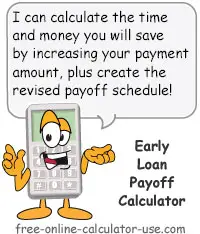IMPORTANT: Numeric entry fields must not contain dollar signs, percent signs, commas, spaces, etc. (only digits 0-9 and decimal points are allowed).
Click the Terms tab above for a more detailed description of each entry.
Step #1:
Enter the loan's current balance.
Step #2:
Enter the annual interest rate of the loan.
Step #3:
Enter the current monthly payment amount.
Step #4:
Enter the extra amount you can afford to add to your current monthly loan payment.
Step #5:
If you would like the amortization schedule to be included in the results, move the slider to "Yes" and select the month and enter the year you want the schedule to start at.
Step #6:
Click the "Calculate Payoff Savings" button.
Step #7:
If you chose to include the amortization schedule in the results and would like to open a printer-friendly report for printing, scroll to the bottom of the schedule and click the "Printer Friendly Schedule" button. This will open the report in its own window for printing.


Follow me on any of the social media sites below and be among the first to get a sneak peek at the newest and coolest calculators that are being added or updated each month.